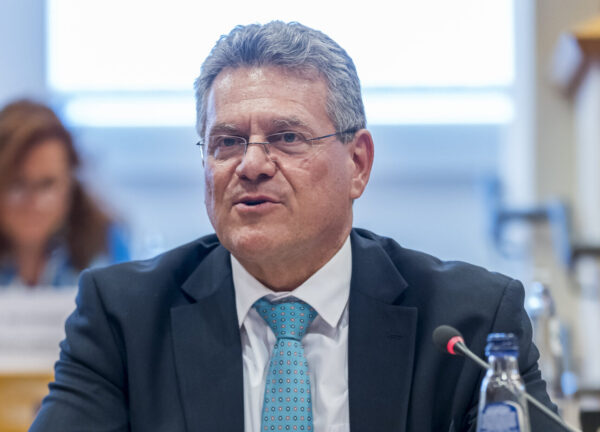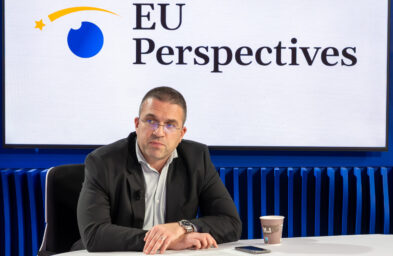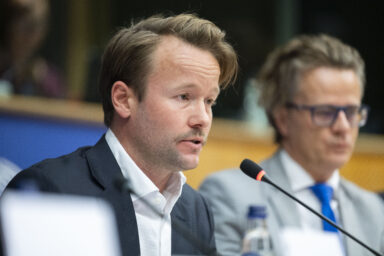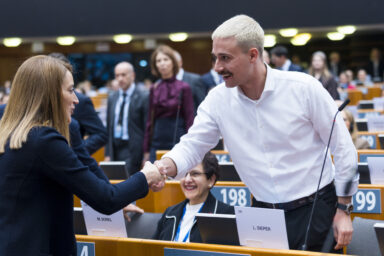EU trade chief Maroš Šefčovič meets US counterparts in Washington on Thursday, seeking to secure a deal to avoid tariffs hitting 50 per cent on nearly all the bloc‘s exports. Brussels expects an interim agreement to extend talks, prioritising relief for critical sectors like cars and steel while dodging a costly transatlantic trade war.
Maroš Šefčovič, the EU’s longest-serving commissioner, finds himself at the centre of last-ditch negotiations in Washington this week. His mission is to avert a transatlantic trade war by securing a deal with Donald Trump’s administration before steep US tariffs on €380bn of EU exports—70 per cent of the bloc’s total shipments to America—take effect on 9 July. The Slovak diplomat, renowned for his unflappable pragmatism, faces his sternest test yet as he races to reconcile Brussels’ red lines with Washington’s demands. With talks set to conclude today, 3 July, the outcome will hinge on whether Trump’s transactional instincts can accommodate Europe’s plea for fairness.
The EU has signalled willingness to accept a 10 per cent universal tariff on many exports to the US, but insists on lower rates for critical sectors: pharmaceuticals, semiconductors, commercial aircraft, and alcohol. Quotas and exemptions are also in the offing to soften Washington’s 25 per cent tariff on cars and 50 per cent levies on steel and aluminium, which disproportionately hit German automakers and French metal producers. Though the proposed arrangement slightly favours the US, EU negotiators view it as palatable in comparison to the alternative: a 50 per cent tariff surge on nearly all exports. “We’re negotiating hard, but asymmetry is inevitable,” admitted a Brussels insider to The Guardian, a British daily.
Tariffs, timelines, tactics
Mr Trump’s combative trade agenda has left little room for compromise. He frames tariffs as tools to revive US manufacturing, fund tax cuts, and curb perceived exploitation by trading partners. The EU, however, sees the 9 July deadline as less a negotiation tool than an ultimatum. “We are deeply engaged, but all options remain on the table,” an EU Commission spokesperson said somewhat cryptically, alluding to retaliatory measures primed for activation.
Stephen Miran, chair of Trump’s Council of Economic Advisers, struck a more optimistic tone: “There’s genuine political will to reach a deal.” Investors, too, appear cautiously hopeful. “The glass is half full,” said Vincent Juvyns of ING, noting that markets still bet on an 11th-hour accord. The numbers underscore the stakes: in 2024, the EU exported €52.8bn in cars and parts to the US, its largest market, alongside €24bn in steel and aluminium—figures that would crater under Trump’s threatened 50 per cent tariffs.
You might be interested
Talks this week aim to finalise an interim agreement by 9 July, allowing further negotiations on thornier issues like non-tariff barriers and strategic purchases of US liquefied natural gas (LNG). But EU officials privately concede that any deal will likely be asymmetric, with Brussels absorbing short-term pain to avoid a broader rupture. The bloc’s chief demand—immediate relief for automotive and metals sectors—faces resistance from US trade hawks eyeing leverage ahead of November’s election.
Retaliation looms in the background
Should talks collapse, the EU has prepared retaliatory tariffs on €21 bn of US goods, targeting politically sensitive products like soybeans from Louisiana (home to House Speaker Mike Johnson) and motorcycles from Wisconsin, a swing state. A secondary list of €95bn in duties, including Boeing aircraft and Kentucky bourbon, awaits activation. Brussels is also exploring export controls and procurement restrictions to exploit US dependencies in critical minerals and pharmaceuticals. “This isn’t just about tariffs—it’s about economic statecraft,” noted an EU trade strategist.
Four scenarios dominate internal discussions: a lopsided-but-acceptable deal, an untenable US offer, a deadline extension, or Mr Trump’s withdrawal. The latter would trigger immediate EU countermeasures, though officials worry such escalation could spiral. “Bringing back tariffs is an aberration,” fumed Emmanuel Macron this week, condemning Trump’s “blackmail” tactics. The French president’s outburst reflects simmering European frustration, even as Commissioner Šefčovič works to keep talks alive.
The sausage king’s last stand
Mr Šefčovič’s career has prepared him for this moment. Since joining the Commission in 2009, he has built a reputation as a discreet fixer—whether smoothing post-Brexit tensions with UK ministers or hi effort to outmanoeuvre populists in Slovakia’s 2019 presidential race. Colleagues describe a man who “doesn’t make enemies”, preferring backroom persuasion to public grandstanding. His breakthrough 2021 deal with th UK’s Michael Gove on Northern Ireland chilled-meat export—the “sausage accord”—showcased his knack for marrying technical rigour with political theatre.
Bringing back tariffs is an aberration. – Emmanuel Macron, President of France
Yet Mr Trump poses a uniquely mercurial counterpart. Their sole prior interaction—a 2019 visit to a Louisiana LNG terminal—ended with the president botching Mr Šefčovič’s name in a rambling speech. This time, the Slovak must reconcile Mr Trump’s “America First” dogma with Europe’s insistence on reciprocity. “He’ll keep proposing ideas until the clock runs out,” predicted a senior EU diplomat, referencing Mr Šefčovič’s tenacity during Brexit talks.
The EU’s calculus hinges on limiting damage. Even a suboptimal deal could spare exporters immediate chaos, buying time for future renegotiations. But Mr Trump, who is eyeing November’s election, may be bent on strong-arming Brussels into lasting concessions. The bloc’s proposed “simplification agenda” for non-tariff barriers—streamlining regulations on everything from medical devices to AI—offers a potential sweetener, as do pledges to buy more US LNG. Yet these gestures fall short of Washington’s demands for guaranteed market access.
A test of resilience
France’s vocal dissent complicates Mr Šefčovič’s task. While Germany’s export-driven economy favours compromise, France insists any deal must address “structural imbalances” in US-EU trade. Italy, meanwhile, bristles at steel tariffs threatening its €3.8bn aluminium exports. Navigating this fragmentation requires the Slovak Commissioner to be equal parts technocrat and therapist—a role he honed during Brexit’s acrimony.
For Mr Šefčovič, the task is personal. His 2019 Slovak presidential defeat—a failed bid to rebrand as a populist—still stings. Now, as trade chief, he embodies the EU’s bet that patience and pragmatism can outlast Mr Trump’s brinkmanship. Colleagues note his relentless work ethic. During a May sprint to secure Asian trade pacts, he slept just two nights in a bed, crisscrossing nine countries in seven days.
The glass is half full. – Vincent Juvyns, ING
His rapport with Commission President Ursula von der Leyen, another pragmatist, proves crucial. The pair, both fitness enthusiasts, are the only senior EU officials known to use the Berlaymont’s basement gym—a metaphor for their shared endurance. “They’re workhorses, not show ponies,” remarked a Brussels insider.
Legacy on the line
As talks resume today, the question is whether Trump’s transactional approach can coexist with Mr Šefčovič’s consensus diplomacy. The Slovak’s playbook—listening intently, probing for flexibility, avoiding ultimatums—faces its toughest audience yet. A face-saving fudge remains possible: extending talks beyond 9 July with token tariff reductions. But with Trump craving “wins” for his base, and Europe wary of surrender, the gap remains vast.
The answer will shape transatlantic trade for years—and define one commissioner’s legacy. Should Mr Šefčovič succeed, he’ll cement his status as Brussels’ indispensable troubleshooter. Failure, however, would embolden critics who see the EU as helpless in an era of economic nationalism.











